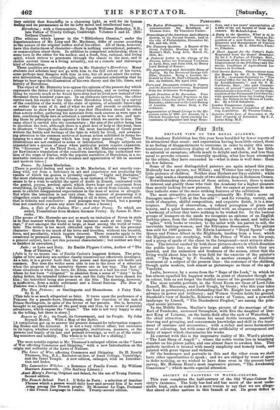/int Itto.
PRIVATE VIEW OF THE ROYAL ACADEMY.
THE Academy Exhibition has this year been heralded by fewer reports of its attractions than usual; and expectation having been little raised, there is no feeling of disappointment to overcome in order to enjoy this unos- tentatious yet satisfactory display of British art ; which, if it has little to astonish or enrapture, affords much to delight and charm, and less than usual to provoke censure. Generally speaking, what has been attempted by the artists, they have succeeded in—what is done is well done : there are few failures.
Some of the most distinguished painters are again missed this year. Mulready has no picture, nor Millais ; and Webster has only two or three little pictures of children. Neither does Herbert nor Dyee exhibit ; while Cope only sends a charming study of two children deep in Robinson Crusoe. Notwithstanding the absence of these artists, however, there is much to interest and gratify those who visit the Academy for a higher pleasure than merely looking for new pictures. But we cannot at present do more than indicate some of the more striking features of the exhibition.
The most attractive picture is unquestionably Mr. Frith's scene on Ramsgate sands—" Life at the Sea-side " : and for vivacity, variety, and truth of character, skilful composition, and exquisite finish, it is a mas- terpiece. Nicety of observation, a refined perception of grace and beauty, and a quiet humour, are combined with an elegance of style and a harmony of colour that leave nothing to be wished for. In the various groups of loungers on the sands we recognize an epitome of an English bathing-place, from the children digging holes in the sand, and ladies in " ughes" with books or crochet, to the sailor with his parrot to sell, the inevitable bathing-women, and the Ethiopian Serenaders. The picture was sold for 1000 guineas. Sir Edwin Landseer's " Royal Sports "—the Queen and Prince Albert in the Highlands, landing from a boat, which the Highlanders are steadying, with the Prince of Wales on his pony, and a group of spoils of the chase in the foreground—next attracts atten- tion. The interest excited by both these pictures shows in which direction the public taste lies ; as the power and address with which they are painted, and the animation and freshness of the scenes, attest that the living world about him is the true field for the exercise of the painter's
" The Swing," by F. Goodall, is another example of felicitous treatment of a subject of the present time : the costumes of the children, though quite modern, look almost as picturesque as those of the age of Vandyke. Leslie, however, by a scene from the " Rape of the Lock," in which he has almost equalled his happiest works in point of character though not in colour, bids us not forget the fruitful source of his greatest triumphs.
The most notable portraits in the Great Room are those of Lord John Russell, Mr. Macaulay, and Lord Gough, by Grant ; who this year takes the lead in portraiture, notwithstanding that Mr. Knight has made a great advance in power and brilliancy ; and Watson Gordon holds his ground. Stanfield's view of Rochelle, Roberts's views of Venice, and a powerful landscape by Linnell, " The Disobedient Prophet," are among the prin- cipal scenic pictures. In the Middle Room, Maclise's large picture of the marriage of the Earl of Pembroke, surnamed Strongbow, with Eva the daughter of Der- mot King of Leinster, on the battle-field after the sack of Waterford, is the chief attraction. It evinces his usual fertile invention, masterly drawing and grouping, and consummate knowledge and skill in the treat- ment of costume and accessories ; with a richer and more harmonious tone of colouring, but with some of that artificiality of arrangement and fixity of aspect which characterize his works.
In contrast with this is the impressive reality of Mr. Ward's picture, " The Last Sleep of Argyll " ; where the noble victim lies in breathing slumber on his prison pallet, and one almost fears to awaken him. This pathetic incident is treated with manly simplicity and homely truth, and painted with great vigour and richness.
Of the landscapes and portraits in this and the other room we shall have other opportunities to speak ; and we are obliged by want of space to defer noticing, as we wished to have done even in the present hasty survey, Mr. Holman Hunt's most impressive picture, "The Awakening Conscience" ; which merits especial attention.


























 Previous page
Previous page